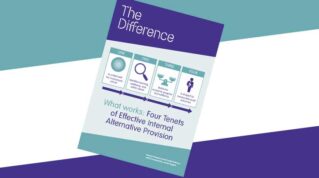From struggling to hand homework in on time and feeling too shy to ask questions to being misinterpreted as rude in the classroom, Georgia’s school experience came with challenges that she did not see her friends face. Then, having spent years of her school life feeling out of sync with her peers, things started falling into place for her when she was diagnosed with autism at the age of 18.
A growing rate of autism diagnosis in children is testament to our increasing awareness. But it also demonstrates the growing demand on teachers to develop their inclusive practice. Georgia is now at university and working as a tutor, and she consistently reflects on her school experiences to inform her tutoring. Her approach is influencing ours as an organisation and, while the classroom setting is of course more complex than a tutoring session, her tips will prove useful for teachers working to create neurodiversity-friendly learning environments.
Communication. Communication. Communication
From my experience, communicating directly with autistic students is the holy grail of creating a neurodiversity-friendly classroom. Autistic people like myself can often struggle to speak up when feeling uncomfortable, but being approached by someone who seems genuinely interested in helping can make addressing our needs a lot easier.
Of course, there are things that can’t logistically be changed; autistic students would find smaller class sizes easier to navigate, for example. But other aspects can be altered with potentially significant results, such as seating plans. Personally, I always felt safer at the back, in a corner, knowing there was no one sat behind me. Sitting like this increased my concentration and even my classroom participation.
When a teacher approaches an autistic student to better understand their needs and makes changes like this, it can boost not only our engagement but our confidence as well.
A safe space to engage
Predictable routines help make the classroom feel safer. This might involve establishing an environment where asking questions is embraced by the entire classroom, where lesson plans are given to students ahead of time and where certain aspects of lessons remain consistent. For example, using the same technological equipment and a similar seating plan would have benefitted me hugely.
Another key factor to note is that autistic students often feel judged when we ask teachers or peers to cater for our specific needs. For example, we might fear we’ll sound immature if we ask to use fidget toys, and yet these can help increase our concentration and lower other disruptive activities. Having a teacher who is open-minded about the use of such tools and who is receptive to our requests makes a world of difference.
Look for the signs
If an autistic student begins to seem uninterested, disengaged or rude, there’s usually something wrong and they’re not sure how to express it. This was my experience, and I was often misinterpreted as having an attitude. In truth, when I was quiet it was because I was struggling and had no way of showing it. Being aware of slight changes in an autistic person’s temperament and engagement and approaching it in the correct way can make a significant difference to our everyday school lives.
We know that autistic students often feel isolated by their experiences, and this can lead to a lower sense of self-confidence than their peers. These experiences are typically unique to them, but the strategies Georgia sets out here have the potential to be more universally beneficial, especially in a post-pandemic context where students’ mental health is an area of broad concern.
Hearing from tutors like Georgia is transforming our provision. Aware of teachers’ already stretched workload, we thought her tips were worth sharing. They are small, sustainable changes with the potential to bolster confidence, engagement and academic attainment. And that can only be a good thing, for autistic students, their peers and their teachers alike.















Please don’t use the puzzle piece on an article about autism!